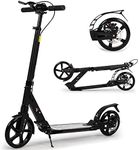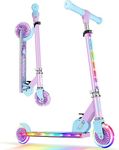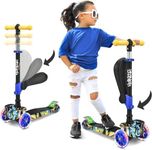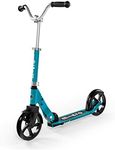Buying Guide for the Best Kids Scooters
Choosing the right kids' scooter can be a fun and rewarding experience. It's important to consider various factors to ensure the scooter is safe, comfortable, and suitable for your child's age and skill level. By understanding the key specifications, you can make an informed decision that will provide your child with hours of enjoyment and physical activity.Age and Weight LimitThe age and weight limit of a scooter indicates the recommended age range and maximum weight the scooter can safely support. This is important to ensure the scooter is suitable for your child's size and developmental stage. Scooters for younger children typically have lower weight limits and are designed with safety features like wider decks and three wheels for stability. For older kids, scooters may have higher weight limits and more advanced features. Choose a scooter that matches your child's age and weight to ensure safety and comfort.
Wheel Type and SizeWheel type and size affect the scooter's performance and ride quality. Larger wheels provide a smoother ride and are better for uneven surfaces, while smaller wheels are more maneuverable and suitable for smooth pavements. Wheels can be made of plastic, rubber, or polyurethane, with rubber and polyurethane offering better grip and durability. Consider where your child will be riding the scooter and choose wheel type and size accordingly. For beginners, larger wheels may be more stable, while experienced riders might prefer smaller, more agile wheels.
Deck Size and MaterialThe deck is the platform where your child stands while riding the scooter. Deck size and material are important for comfort and durability. A wider deck provides more stability, which is ideal for younger children or beginners. Narrower decks are better for older kids who have better balance and control. Decks can be made from plastic, wood, or metal, with metal being the most durable. Choose a deck size and material that matches your child's skill level and riding style.
Handlebar Height and AdjustabilityHandlebar height and adjustability are crucial for ensuring a comfortable and safe riding experience. Adjustable handlebars allow the scooter to grow with your child, providing a longer lifespan for the scooter. The handlebars should be at a comfortable height, typically around waist level, to ensure proper control and posture. Check if the scooter offers adjustable handlebars and choose one that can be set to the appropriate height for your child.
Brake SystemThe brake system is essential for safety, allowing your child to stop the scooter when needed. Scooters can have rear fender brakes, hand brakes, or both. Rear fender brakes are common and easy to use, requiring the rider to step on the fender to slow down. Hand brakes offer more control and are similar to bicycle brakes. Consider your child's age and coordination skills when choosing a brake system. Younger children may find rear fender brakes easier to use, while older kids might prefer the precision of hand brakes.
Foldability and PortabilityFoldability and portability are important for convenience, especially if you need to transport or store the scooter frequently. Foldable scooters are easy to carry and store, making them ideal for families on the go. Check if the scooter has a simple folding mechanism and is lightweight enough for easy handling. If portability is a priority, choose a scooter that is compact and easy to fold.


















